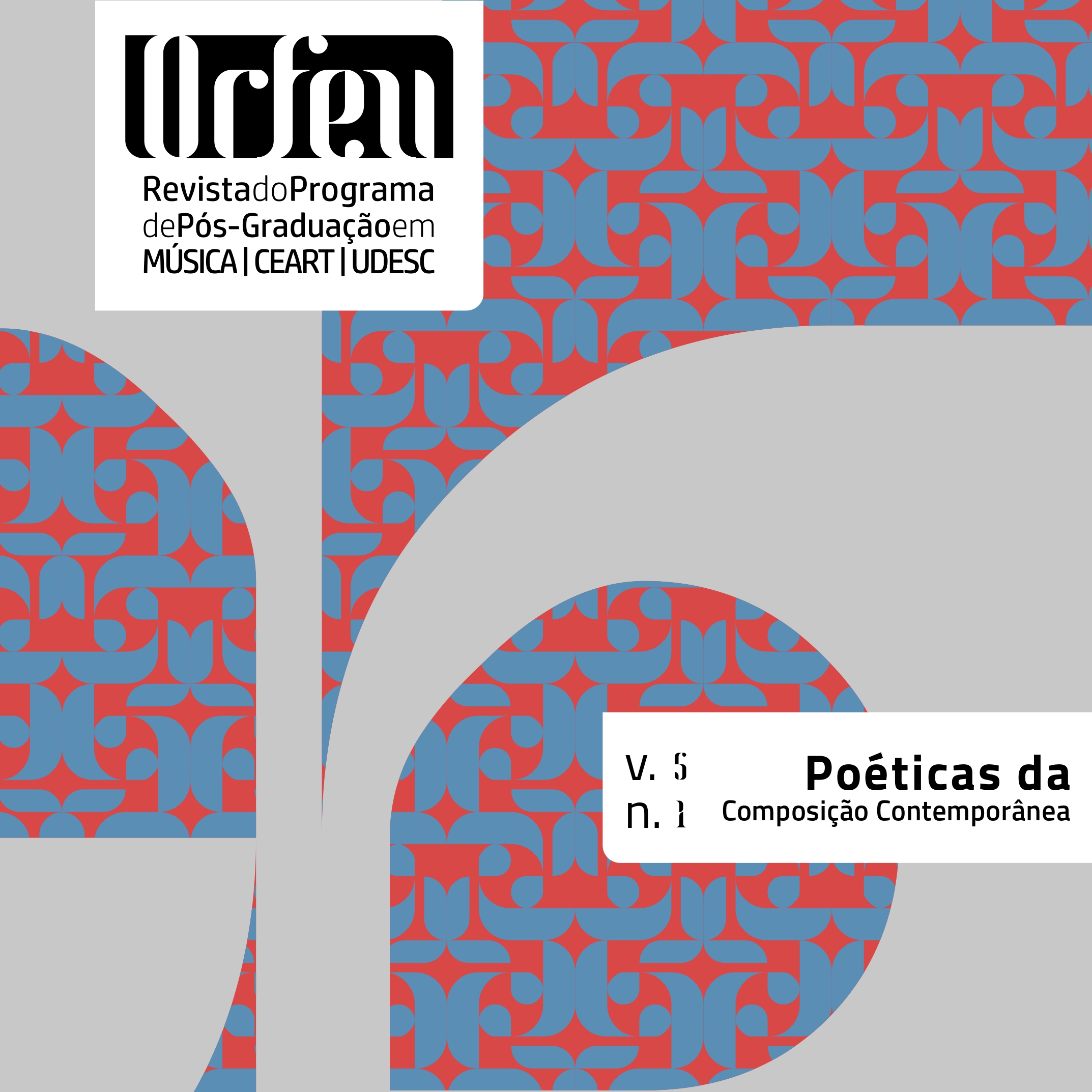Towards the 'secondary worlds' in Henze's opera Elegy for Young Lovers
DOI:
https://doi.org/10.5965/2525530405012020209Parole chiave:
Contemporary opera, pluralism, metalanguage, topics, Hans Werner HenzeAbstract
This article attempts to trace the dramatic-musical origins of the opera in three acts Elegy for Young Lovers (1961), with music by the German composer Hans Werner Henze and libretto by Auden and Kallman. By researching literary and theoretical sources on this work, with emphasis on the authors’ own writings, it was examined the extrinsic resources that contributed to the constitution of the internal dramatic structure. These resources are, on the one hand, cultural influences that interacted in the construction of the artistic identity of the work and, on the other hand, conventions borrowed from other traditions, such as the topics of the lyrical repertoire, the concepts of primary and secondary worlds of fiction literature, and possible references to known personalities, which served as inspiration for the characterization of certain roles. It was found that extrinsic resources, besides contributing to the dramatization processes in opera, also play an important role in the elaboration of an underlying didactic discourse.
Downloads
Riferimenti bibliografici
AUDEN, W. H. Secondary worlds. London: Faber & Faber, 1984.
AUDEN, W. H., ed. The Living Thoughts of Kierkegaard. Introduction by W. H. Auden. New York: The New York Review of Books, 1999.
BERRY, M. Hans Werner Henze: paths to (and From) Natascha Ungeheuer. After Wagner: Histories of Modernist Music Drama from Parsifal to Nono, Woodbridge, Suffolk, UK; Rochester, NY, USA: Boydell & Brewer, p. 172–204, 2014. Accessed April 26, 2020. DOI:10.7722/j.ctt6wpbcx.13.
COOKE, M. ed. The Cambridge Companion to Twentieth century opera. Cambridge/New York/ Melbourne: Cambridge University Press, 2005.
EDGECOMBE, Rodney, Stenning. Topoi and melodic morphology in the operas of Donizetti. The Musical Times, 155, no. 1926 (2014): 67–80. Accessed April 26, 2020. www.jstor.org/stable/24615705.
FULLER, J. W.H. AUDEN: a commentary. Princeton Oxford, University Press: 1998.
HENZE, H.W. Elegy for Young Lovers. Opera in three acts by W. H. Auden and Chester Kallman. Mainz: Schott, 1989.
HENZE, H.W. Elegy for Young Lovers. (1959/61—Revised Version 1989). Opera in three acts by Wystan H. Auden and Chester Kallmann. Deutsche Fassung von Ludwig Landgraf unter Mitarbeit von Wener Schachteli und dem Komponisten. Study Score. (ED 8776) Mainz/ London/ Madrid.
HENZE, H.W. Elegy for Young Lovers. Revised Version 1987. Opera in three acts by Wystan H. Auden and Chester Kallmann. Revised Version 1987. Deutsche Fassung von Ludwig Landgraf unter Mitarbeit von Wener Schachteli und dem Komponisten. Klavierauszug von Markus Lehmann. Study Score. (ED 5100) Mainz/ London/ Madrid.
HENZE, H. W. Music and Politics. Collected Writings 1953–1981. Translated and edited by Peter Labanyi. London: Faber & Faber, 1982.
HATTEN, R. S. Pluralism of Theatrical Genre and Musical Style in Henze’s “We Come to the River.” Perspectives of New Music, vol. 28, no. 2 (Summer, 1990): 292–311.
HUOVINEN, E., KAILA, A.. The Semantics of Musical Topoi: An Empirical Approach.
Music Perception: An Interdisciplinary Journal 33, no. 2 (2015): 217–43. Accessed April 29, 2020. doi:10.1525/mp.2015.33.2.217.
LACHENMANN, H.; STADELMAN, J. Open Letter to Hans Werner Henze. Perspectives of New Music, vol. 35, no. 2 (Summer, 1997): 189–200.
MICZNIK, V. Of Ways of Telling, Intertextuality, and Historical Evidence in Berlioz’s “Roméo et Juliette.” 19th-Century Music 24, no.1 (2000): 21–61. Accessed April 29, 2020. doi:10.2307/746871.
NORTHCOTT, BAYAN, STRAVINSKY, HENZE. Notes on Auden: 2. Life after Britten? Bayan Northcott Completes His Survey of Auden’s Life in Music by considering the Poet’s Collaborations with Stravinsky, Henze, and Others. The Musical Times, vol.134, no.1800 (February 1993): 68–72.
PETERSEN, Peter. “Henze, Hans Werner.” MGG2: 1325–1352.
PORTER, A. Elegy for Young Lovers. The Musical Times, vol. 102, no. 1421 (July 1961): 418–419.
PORTER, A. Henze’s ‘Young Lord’. The Musical Times, vol. 110, no. 1520 (October 1969): 1028–1030.
SHAKESPEARE. Macbeth. Available from https://www.opensourceshakespeare.org/views/plays/play_view.php?WorkID=macbeth&Scope=entire&pleasewait=1&msg=pl#a5,s5 (accessed April 29, 2020).
ROTH, M. A. The Sound of a Poet Singing Loudly: A Look at “Elegy for Young Lovers”.
Comparative Drama, vol. 13, No. 2 (Summer, 1979): 99–120.
THEILACKER, J. B. ‘Grazie und Härte, Kühle und Feuer’ Gegensätze in Henzes Oper Der Prinz von Homburg. In Theater ist ein Traumort. Opern des 20. Jahrhunderts von Janáček bis Widmann, herausgeben von Hanspeter Krellmann und Jürgen Schläder (Berlin: Henschel, 2005): 213–217.
WALTER, B. “Prekäre angewandte Opernästhetik: Audens ‘sekundäre Welt’ und Hans
Werner Henzes Elegie für junge Liebende”. In Die Semantik der musiko-literarischen
Gattungen: Methodik und Analyse; eine Festgabe für Ulrich Wisstein zum 65. Geburtstag. Herausgegeben von Walther Berhart, 233–246.Tübingen: Narr, 1994.
WHITTALL, A. Henze’s Haunted Sensibility. The Musical Times, vol. 147, no. 1895 (Summer 2006): 5–15.
Downloads
Pubblicato
Come citare
Fascicolo
Sezione
Licenza
Copyright (c) 2020 ORFEU

TQuesto lavoro è fornito con la licenza Creative Commons Attribuzione 4.0 Internazionale.






